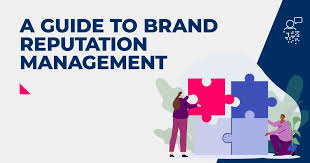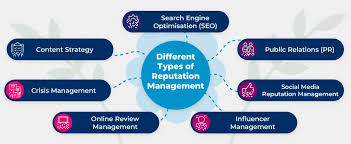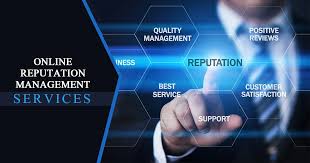In the age of social media, instant reviews, and digital word-of-mouth, a company’s reputation can make or break its success. Whether you run a small business or a global brand, your reputation is one of your most valuable assets. That’s where brand reputation management comes in—a strategic process of shaping public perception, responding to feedback, and fostering long-term trust with your audience.
In this article, we’ll explore what brand reputation management is, why it matters, how to build and protect your brand’s image, and what tools and strategies companies can use to ensure their name stands strong in the public eye.
Brand Reputation Management

What is brand reputation management?
Brand reputation management is the practice of influencing how your brand is perceived by customers, stakeholders, and the general public. It involves monitoring, responding to, and shaping the conversations people are having about your brand—both online and offline.
This process includes:
- Addressing customer complaints and negative reviews
- Promoting positive stories and testimonials
- Managing public relations during crises
- Maintaining transparency and consistency in communication
In simple terms, it’s about controlling the narrative around your business, ensuring that your brand is trusted, respected, and seen in a positive light.
Why Is Brand Reputation Important?
Your brand reputation affects everything—from customer trust to sales to employee retention. Here are some key reasons why managing your brand reputation is essential:
1. Trust Equals Loyalty
Customers are more likely to do business with brands they trust. A strong, positive reputation leads to repeat customers, word-of-mouth marketing, and long-term loyalty.
2. Impacts Purchase Decisions
According to studies, over 85% of consumers read online reviews before making a purchase. Even a single negative review can influence buying behavior.
3. Attracts Top Talent
People want to work for companies with a positive image. Your brand reputation plays a big role in attracting skilled employees and keeping your current team motivated.
4. Investor Confidence
A respected brand attracts investors and partners. A well-managed reputation demonstrates stability, professionalism, and growth potential.
5. Crisis Resilience
When a crisis hits—be it a product issue, social controversy, or PR scandal—a good reputation acts as a protective shield. Loyal customers are more likely to give you the benefit of the doubt.
Brand Reputation Management

Components of Brand Reputation Management
To effectively manage your brand’s reputation, you need to cover several key areas:
✅ 1. Online Reviews
Platforms like Google, Yelp, and Trustpilot are where consumers share their experiences. Monitoring and responding to reviews—especially negative ones—can significantly influence public perception.
✅ 2. Social Media Presence
Social media is where brands are praised or criticized in real time. Active engagement, timely responses, and positive interactions are crucial.
✅ 3. Search Engine Results
What shows up when someone Googles your brand? SEO and content marketing help control which pages appear on the first page of search results, keeping negative press buried and highlighting positive content.
✅ 4. Customer Service
Every customer interaction is an opportunity to strengthen or damage your reputation. Efficient, friendly, and solution-oriented service builds goodwill.
✅ 5. Public Relations (PR)
PR campaigns help shape your brand’s image in the media. Whether launching a product or addressing a controversy, strategic PR builds trust and credibility.
Table of Contents
Strategies to Build and Maintain a Positive Brand Reputation
🌟 1. Deliver Consistent Quality
Your product or service is your foundation. Nothing damages a reputation faster than poor quality or broken promises. Aim to exceed expectations consistently.
🌟 2. Monitor Your Brand Online
Use tools like
- Google Alerts
- Hootsuite
- Brandwatch
- Mention
These tools help you track what’s being said about your brand across the web and social media.
🌟 3. Respond to Feedback Promptly
Acknowledge negative feedback without becoming defensive. Offer solutions, and thank customers for their honesty. This shows accountability and care.
🌟 4. Encourage Positive Reviews
Happy customers often stay silent. Politely ask them to share their experiences on review platforms or social media.
Example:
“We’re glad you had a great experience! If you have a moment, we’d appreciate a quick review on Google.”
🌟 5. Be Transparent and Honest
If you make a mistake, own it. Transparency in crises is better than cover-ups. People appreciate brands that are honest, even when things go wrong.
🌟 6. Leverage Influencers and Advocates
Partner with influencers or brand ambassadors who genuinely support your business. Their endorsement builds credibility and visibility.

🌟 7. Create Positive Content
Publish blogs, videos, case studies, and press releases that highlight your brand’s strengths, community involvement, and success stories.
Dealing with a Reputation Crisis
Even the best brands can face backlash or criticism. What sets strong brands apart is how they respond during tough times.
🔥 Crisis Management Steps:
- Acknowledge the issue publicly
- Apologize sincerely if your brand was at fault
- Take immediate corrective action
- Communicate openly and frequently
- Follow up with long-term changes or improvements
Example: When a well-known brand faces backlash over a faulty product, issuing a recall, apologizing publicly, and offering refunds or replacements shows responsibility and care.
Real-World Examples of Reputation Management
✅ Nike
Nike has built a reputation around innovation and social causes. When facing controversies (e.g., their ad campaigns with Colin Kaepernick), they stood by their values. While it sparked debate, it strengthened brand loyalty among core audiences.
✅ Starbucks
When Starbucks faced backlash over racial bias, they quickly responded by:
- Closing stores for employee training
- Issuing a public apology
- Launching diversity programs
This proactive response helped repair their image and rebuild trust.
The Role of Employees in Reputation
Your employees are brand ambassadors. Their behavior, attitude, and customer interactions directly reflect on your business.
To engage employees:
- Provide training on brand values
- Encourage open communication
- Reward excellent service
- Promote a positive workplace culture
Tools for Brand Reputation Management
Here are some helpful tools businesses use to monitor and manage their brand reputation:
| Tool | Use |
|---|---|
| Google Alerts | Tracks brand mentions online |
| Hootsuite | Manages social media and customer interaction |
| Trustpilot | Collects and displays customer reviews |
| Brand24 | Monitors real-time brand mentions |
| Sprout Social | Helps with social listening and engagement |
| SEMrush | Manages SEO and online visibility |
Measuring Reputation Success
You can’t improve what you don’t measure. Track these key metrics:
- Net Promoter Score (NPS)—measures—measuresoyalty
- Online review ratings—s—average rating across platforms
- Brand sentiment—t—positive vs negative mentions
- Media coverage—quantity and tone
- Customer retention rate
Regularly reviewing these KPIs helps you refine your reputation strategy.

Conclusion: Protecting Your Brand is Protecting Your Future
In today’s fast-paced, hyperconnected world, brand reputation management is not optional—it’s essential. Every tweet, comment, or review can shape how the world sees your business. Managing your reputation is about more than just avoiding bad press; it’s about actively building trust, showing transparency, and consistently delivering value.
By embracing best practices, using the right tools, and listening closely to your audience, you can create a reputation that drives growth, loyalty, and lasting success.
SEO Title: Brand Reputation Management: 7 Powerful Strategies to Build Trust
Meta Description: Learn how to manage your brand’s reputation with proven strategies. Explore tools, case studies, and tips to build trust and stay ahead in business.

